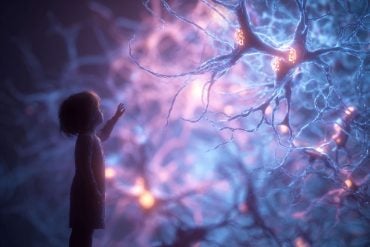Summary: A new study shows that gold nanoparticles injected into the retina can restore vision in mice with retinal degeneration, offering a less invasive alternative to current retinal prostheses. When activated by patterned infrared light, these nanoparticles stimulate retinal cells, bypassing damaged photoreceptors.
This activation leads to visual signal transmission to the brain, confirmed by activity in the visual cortex. Researchers envision a future device combining these nanoparticles with laser-equipped goggles to restore functional vision in humans.
Key Facts:
- Targeted Activation: Gold nanoparticles stimulate bipolar and ganglion cells using infrared light.
- Non-Invasive Approach: Unlike electrode implants, nanoparticle delivery uses simple eye injections.
- Restored Visual Signals: Brain imaging confirmed visual cortex activation post-treatment in mice.
Source: Brown University
A new study by Brown University researchers suggests that gold nanoparticles — microscopic bits of gold thousands of times thinner than a human hair — might one day be used to help restore vision in people with macular degeneration and other retinal disorders.
In a study published in the journal ACS Nano and supported by the National Institutes of Health, the research team showed that nanoparticles injected into the retina can successfully stimulate the visual system and restore vision in mice with retinal disorders.
Video Credit: Neuroscience News
The findings suggest that a new type of visual prosthesis system in which nanoparticles, used in combination with a small laser device worn in a pair of glasses or goggles, might one day help people with retinal disorders to see again.
“This is a new type of retinal prosthesis that has the potential to restore vision lost to retinal degeneration without requiring any kind of complicated surgery or genetic modification,” said Jiarui Nie, a postdoctoral researcher at the National Institutes of Health who led the research while completing her Ph.D. at Brown.
“We believe this technique could potentially transform treatment paradigms for retinal degenerative conditions.”
Nie performed the work while working in the lab of Jonghwan Lee, an associate professor in Brown’s School of Engineering and a faculty affiliate at Brown’s Carney Institute for Brain Science, who oversaw the work and served as the study’s senior author.
Retinal disorders like macular degeneration and retinitis pigmentosa affect millions of people in the U.S. and around the world. These conditions damage light-sensitive cells in the retina called photoreceptors — the “rods” and “cones” that convert light into tiny electric pulses.
Those pulses stimulate other types of cells further up the visual chain called bipolar and ganglion cells, which process the photoreceptor signals and send them along to the brain.
This new approach uses nanoparticles injected directly into the retina to bypass damaged photoreceptors. When infrared light is focused on the nanoparticles, they generate a tiny amount of heat that activates bipolar and ganglion cells in much the same way that photoreceptor pulses do.
Because disorders like macular degeneration affect mostly photoreceptors while leaving bipolar and ganglion cells intact, the strategy has the potential to restore lost vision.
In this new study, the research team tested the nanoparticle approach in mouse retinas and in living mice with retinal disorders. After injecting a liquid nanoparticle solution, the researchers used patterned near-infrared laser light to project shapes onto the retinas.
Using a calcium signal to detect cellular activity, the team confirmed that the nanoparticles were exciting bipolar and ganglion cells in patterns matched the shapes projected by the laser.
The experiments showed that neither the nanoparticle solution nor the laser stimulation caused detectable adverse side effects, as indicated by metabolic markers for inflammation and toxicity.

Using probes, the researchers confirmed that laser stimulation of the nanoparticles caused increased activity in the visual cortices of the mice — an indication that previously absent visual signals were being transmitted and processed by the brain.
That, the researchers say, is a sign that vision had been at least partially restored, a good sign for potentially translating a similar technology to humans.
For human use, the researchers envision a system that combines the nanoparticles with a laser system mounted in a pair of glasses or goggles.
Cameras in the goggles would gather image data from the outside world and use it to drive the patterning of an infrared laser. The laser pulses would then stimulate the nanoparticles in people’s retinas, enabling them to see.
The approach is similar to one that was approved by the Food and Drug Administration for human use a few years ago. The older approach combined a camera system with a small electrode array that was surgically implanted in the eye. The nanoparticle approach has several key advantages, according to Nie.
For starters, it’s far less invasive. As opposed to surgery, “an intravitreal injection is one of the simplest procedures in ophthalmology,” Nie said.
There are functional advantages as well. The resolution of the previous approach was limited by the size of the electrode array — about 60 square pixels.
Because the nanoparticle solution covers the whole retina, the new approach could potentially cover someone’s full field of vision. And because the nanoparticles respond to near-infrared light as opposed to visual light, the system doesn’t necessarily interfere with any residual vision a person may retain.
More work needs to be done before the approach can be tried in a clinical setting, Nie said, but this early research suggests that it’s possible.
“We showed that the nanoparticles can stay in the retina for months with no major toxicity,” Nie said of the research.
“And we showed that they can successfully stimulate the visual system. That’s very encouraging for future applications.”
Funding: The research was funded by the National Institutes of Health’s National Eye Institute (R01EY030569), the China Scholarship Council scholarship, the Saudi Arabian Cultural Mission scholarship, and South Korea’s Alchemist Project Program (RS-2024-00422269). Co-authors also include Professor Kyungsik Eom from Pusan National University, Brown Professor Tao Lui, as well as Brown students Hafithe M. Al Ghosain, Alexander Neifert, Aaron Cherian, Gaia Marie Gerbaka, and Kristine Y. Ma.
About this AMD and visual neuroscience research news
Author: Kevin Stacey
Source: Brown University
Contact: Kevin Stacey – Brown University
Image: The image is credited to Neuroscience News
Original Research: Closed access.
“Intravitreally Injected Plasmonic Nanorods Activate Bipolar Cells with Patterned Near-Infrared Laser Projection” by Jiarui Nie et al. ACS Nano
Abstract
Intravitreally Injected Plasmonic Nanorods Activate Bipolar Cells with Patterned Near-Infrared Laser Projection
Retinal prostheses aim to restore vision in individuals affected by degenerative conditions, such as age-related macular degeneration and retinitis pigmentosa.
Traditional approaches, including implantable electrode arrays and optogenetics, often require invasive surgery or genetic modification and face limitations in spatial resolution and visual field size.
While emerging nanoparticle-based methods offer minimally invasive solutions, some of them rely on intense visible light, which may interfere with residual vision.
Plasmonic gold nanorods (AuNRs), tuned to absorb near-infrared (NIR) light, provide a promising alternative by enabling photothermal neuromodulation without affecting the remaining sight.
However, effectively utilizing photothermal stimulation with patterned laser projection for precise neural activation remains underexplored.
In this study, we introduce a less invasive approach using intravitreally injected anti-Thy1 antibody-conjugated AuNRs to primarily activate bipolar cells─a target traditionally reached through more invasive subretinal injections.
This technique allows for extensive retinal coverage and facilitates high-resolution visual restoration via patterned NIR stimulation.
Following injection, a scanning NIR laser beam projected in a square pattern with a spot size of 20 μm consistently triggered highly localized neuronal activation, specifically stimulating bipolar cells through temperature-sensitive ion channels.
In vivo, this patterned stimulation evoked electrocorticogram responses in the visual cortex of both wild-type and fully blind mouse models without inducing systemic toxicity or significant retinal damage.
Our innovative approach promises significant advancements in spatial resolution and broad applicability, offering a precise, customizable, and less invasive method to restore vision.







